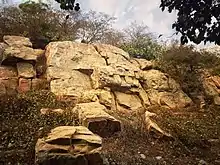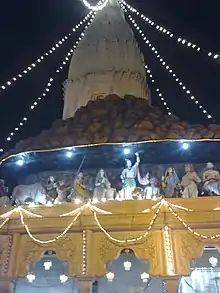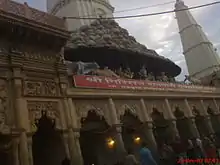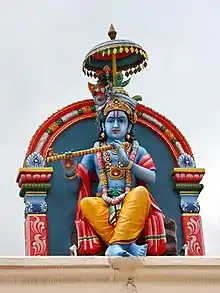Govardhan Hill
Govardhan Hill (Sanskrit: गोवर्धन पर्वत; Govardhana Parvata; Pronunciation: [ɡoʋəɾdʱən]), also called Mount Govardhana and Giriraj, is a sacred Hindu site in the Mathura district of Uttar Pradesh, India on an 8 km long hill located in the area of Govardhan and Radha Kund,[1][2] which is about 21 kilometres (13 mi) from Vrindavan.[3] It is the sacred centre of Braj and is identified as a natural form of Krishna, the Govardhana Shila.[4][5]

Etymology
The name 'Govardhana' has two primary translations. In the literal meaning, 'Go' translates to 'cows', and 'vardhana' translates to 'nourishment'. Another meaning of 'Go' is 'the senses' and 'vardhana' can also mean 'to increase' - thus the name is also translated by devotees of Krishna as 'that which increases the senses' in their attraction to Krishna. In this connection, it is believed that the personality of Govardhan blesses the devotee by increasing his devotion (bhakti).
Geography
Govardhan Hill, stretching from Radha Kund to south of Govardhan, is a long ridge that, at its highest, stands 100 feet (30 m) above the surrounding land. At the southern end of the hill is the village of Punchari, while at the crest stand the villages of Aanyor and Jatipura.[6] The parikarma path of Govardhan hill is intersected by some part of district Bharatpur of Rajasthan.
Background
Govardhan Hill is considered a sacred site because it is the setting for many legends relating to the life of Lord Krishna, the deity believed to be embodied in the earth of the hill. Krishna and his brother Balarama are said to have spent many happy hours roaming among its shade providing groves, pools, caves and lush cow-pastures. An Eden-like sanctuary, the area's waterfalls, garden-grove (van), arbour (nikunj), water tank (kund), and flora are depicted in scenes of Krishna's adventures with Radha.[6]
Temples

The buildings and other structures on the Hill date from the sixteenth century. As of 2013, there is no known archaeological evidence of any remains of greater age.[7]
A few of the sites include:
- The sandstone monument and lake of Kusum Sarovar.[1][2]

- Giriraj Temple[8]

. The Giriraji is dressed as Shrinathji every night as it is believed Shrinathji comes to Govardhan every night.
- Shri Mahaprabhuji Baithakji- The Baithak of Mahaprabhuji Shri Vallabhacharya, that is in front Giriraj Temple.
- Shri Chaitanya Temple, built of red sandstone and adorned with paintings of Krishna and Radha[9]
- Radha Kund Temple[9]
- Mansi Ganga Lake[9]
- Danghati Temple[9]
 Mansi Ganga
Mansi Ganga
Legends
There are legends of Krishna’s saving the hill from a flood, dalliances with gopis (cow-herders)’, and interactions with demons and gods. Artwork has been created of the hill represented as a bull and a peacock, Krishna in a cave, the hill as a mountain of food, depicted in the floods brought on by Indra, and with the Yamuna River.[6]
According to the Giriraj Chalisa (a forty verse hymn dedicated to Govardhan Hill) Govardhan in human form, went to Vrindavan with Pulastya and decided to stay there evermore. The sight of Govardhan Hill and Yamuna River in Vrindavan attracted the demigods who took forms of trees, deer, and monkeys to live in Vrindavan.
The lifting of Govardhan


Govardhan Puja is celebrated on the day after Diwali. It is the day upon which Lord Krishna defeated Indra, the deity of thunder and rain. As per the story, Krishna saw huge preparations for the annual offering to Indra and questions his father Nanda about it. He debated with the villagers about what their 'dharma' truly was. They were farmers, they should do their duty and concentrate on farming and protection of their cattle. He continued to say that all human beings should merely do their 'dharma', to the best of their ability and not pray or conduct sacrifices for natural phenomenon. The villagers were convinced by Krishna, and did not proceed with the special puja. Indra was then angered, and flooded the village. Krishna then lifted Mt Govardhan and held it up as protection to the people and cattle from the rain. Indra finally accepted defeat and recognized Krishna as the victor. He offered his prayers and left to his heavenly kingdom. According to some sources, the destructive cloud sent by Indra is Sāṁvartaka.[10] This aspect of Krishna's life is mostly glossed over, but it actually set up on the basis of the karma-focused philosophy later detailed in the Bhagavad Gita.[11]
The incident represented the downfall of Indra, and a new beginning in Hindu philosophy, from a more sacrifice-oriented worship to a more spiritual plane of thought.
Recent development
In 2018, the Uttar Pradesh Chief Minister Yogi Adityanath declared Govardhan as a pilgrimage centre along with Mathura, Baldev, Nandgaon, Radha Kund, and Gokul.[12] The Yogi Adityanath Government has also planned to rejuvenate Govardhan Parvat with Dvapara Yuga flora such as kadamb, karoli, tamal, pakkad, and tilkan.[13]
References
- Dev Prasad (27 January 2015). Krishna: A Journey through the Lands & Legends of Krishna. Jaico Publishing House. pp. PT 147. ISBN 978-81-8495-170-7.
- Henry George Keene (1878). A Handbook for Visitors to Agra and Its Neighbourhood. Thacker, Spink. pp. 71–72.
- "Vrindavan to Radha Kund". Google mpas. Retrieved 7 April 2017.
- David L. Haberman, River of Love in an Age of Pollution: The Yamuna River of Northern India, Page 264 ISBN 0-520-24789-2
- Kapila D. Silva; Neel Kamal Chapagain (2013). Asian Heritage Management: Contexts, Concerns, and Prospects. Routledge. p. 178. ISBN 978-0-415-52054-6.
- Kapila D. Silva; Neel Kamal Chapagain (2013). Asian Heritage Management: Contexts, Concerns, and Prospects. Routledge. pp. 178–179. ISBN 978-0-415-52054-6.
- Kapila D. Silva; Neel Kamal Chapagain (2013). Asian Heritage Management: Contexts, Concerns, and Prospects. Routledge. p. 180. ISBN 978-0-415-52054-6.
- Ritika Handoo (2 December 2016). "Here Lord Krishna lifted Govardhan hill—This can be your travel guide to reach Giriraj Temple!". ZeeNews. Retrieved 7 April 2017.
- Amit Sengupta (16 June 2015). "Spiritual Sojourn (sic) in Govardhan". Retrieved 7 April 2017.
- Prabhupada, His Divine Grace A. C. Bhaktivedanta Swami. Krsna, the Supreme Personality of Godhead. The Bhaktivedanta Book Trust. ISBN 978-91-7149-558-7.
- "Bhagavad Gita Chapter 3 - Karma Yoga". Bhagavad Gita. Retrieved 8 June 2018.
- "Five more places declared as 'teerth sthals' in Mathura | Agra News - Times of India". The Times of India.
- Dua, Rohan (4 January 2018). "With ancient flora, UP plans to revive Govardhan Parvat". The Times of India. Retrieved 13 April 2020.
Further reading
- Rajasekhara Dasa (2001). Govardhana Hill: India's Most Sacred Mountain. Vedanta Vision Publications. ISBN 978-1-310-32111-5.
External links
![]() Media related to Govardhan Hill at Wikimedia Commons
Media related to Govardhan Hill at Wikimedia Commons
- Srila Prabhupada explains Govardhana Puja Archived 5 May 2018 at the Wayback Machine
- http://www.icompositions.com/music/song.php?sid=199187Ballad of Govardhana Archived 29 December 2014 at the Wayback Machine
- Ballad of Govardhana Hill Archived 29 December 2014 at the Wayback Machine
- The Story of Govardhan
- krishna story lifting govardhan parvat
- Pictures of Govardhan Hill Archived 17 November 2015 at the Wayback Machine
- Exclusive video of Parikrama of Govardhan Hill

